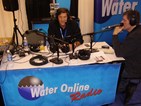Probing For Pipe Leaks

Chuck Hansen, CEO of Electro Scan, talks about the unique technology his company uses to detect leaks and control inflow and infiltration. Unlike CCTV, Electro Scan’s probe technique allows customers to not only see water loss, but measure it.
The following is an excerpt from the Q&A with Water Online Radio. Click on the Radio Player above to hear the full interview.
Water Online Radio: Tell us all about Electro Scan. What do you do? How do you serve your market?
Chuck Hansen: I think, traditionally, people are familiar with closed circuit television inspections – CCTV. Put a camera in a pipe and you’ll look at a defect. The operator will go down and look at the pipe and record the defects based on a standard.
What Electro Scan does – it is a probe that is surrounded by water and actually finds every leak in a sanitary sewer pipe – any non-conductive pipe. That’s what we do. We find leaks. For any city, county, or sewer utility that’s under EPA consent decree, this is the solution.
Water Online Radio: Talk a little bit more about the technology. Is there anything unique in it?
Chuck Hansen: Electro Scan has done what no other technique has done for inspecting sewers; we actually come up with the gallons per minute – and for your UK audience, that’s liters per second – of infiltration going into the pipe.
Water Online Radio: Why is that important for us to know that?
Chuck Hansen: Unfortunately, when it rains, if there are leaks in a pipe, rain water will go into the sanitary sewer system and unnecessarily be transported down to the treatment where there is a specific cost of treating that wastewater.
That water, that rain water, belongs in a storm drain. So, what the EPA and communities are really going for is taking out that infiltration that is seeping in, percolating down through all of these leaks into the pipe.
For 50 years we really haven’t been able to identify where those leaks are going. So, every gallon that we can eliminate of rainfall infiltration is a gallon less we have to treat at this huge treatment plant, and forego capital costs that our cities can’t afford.
